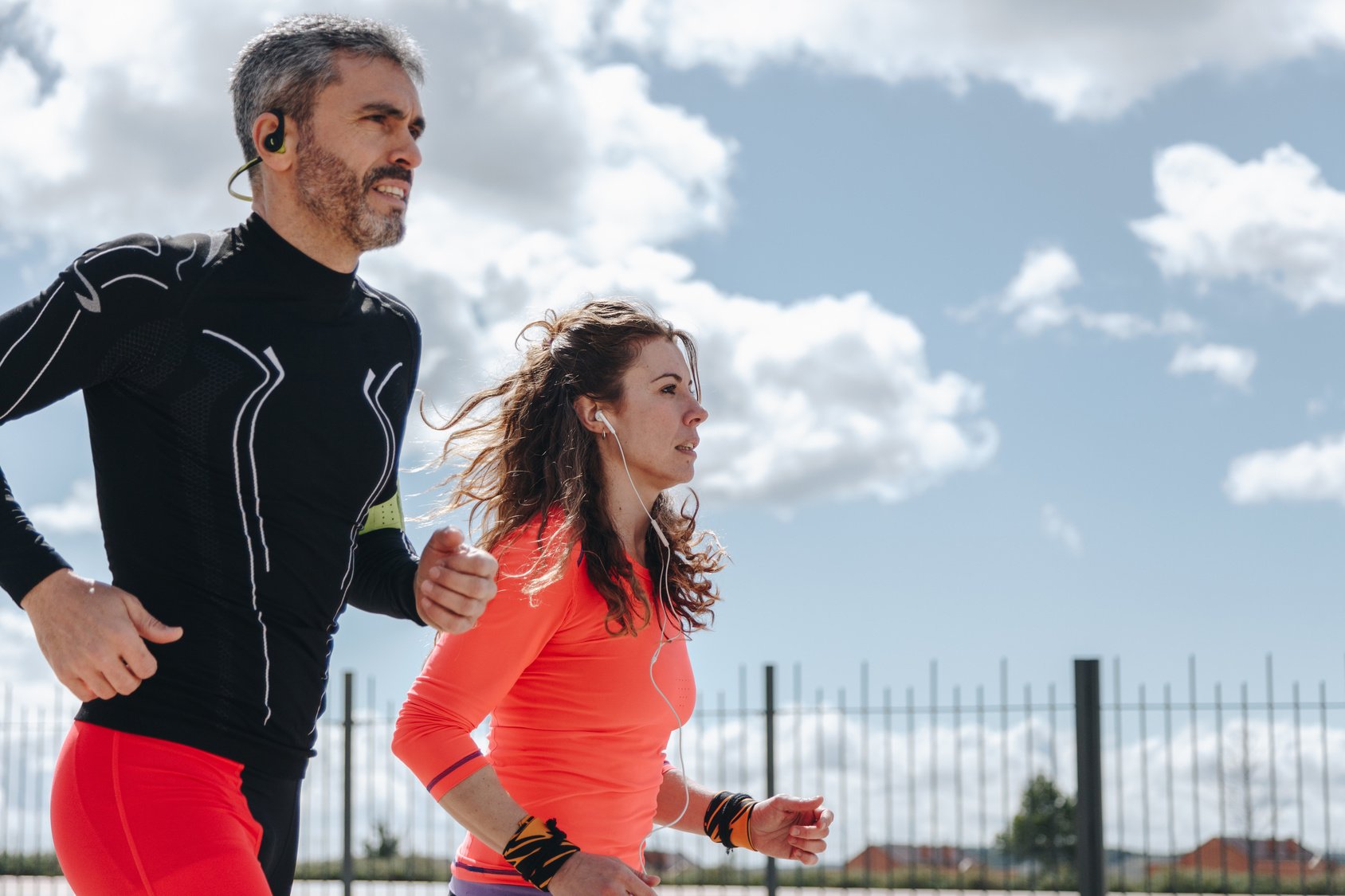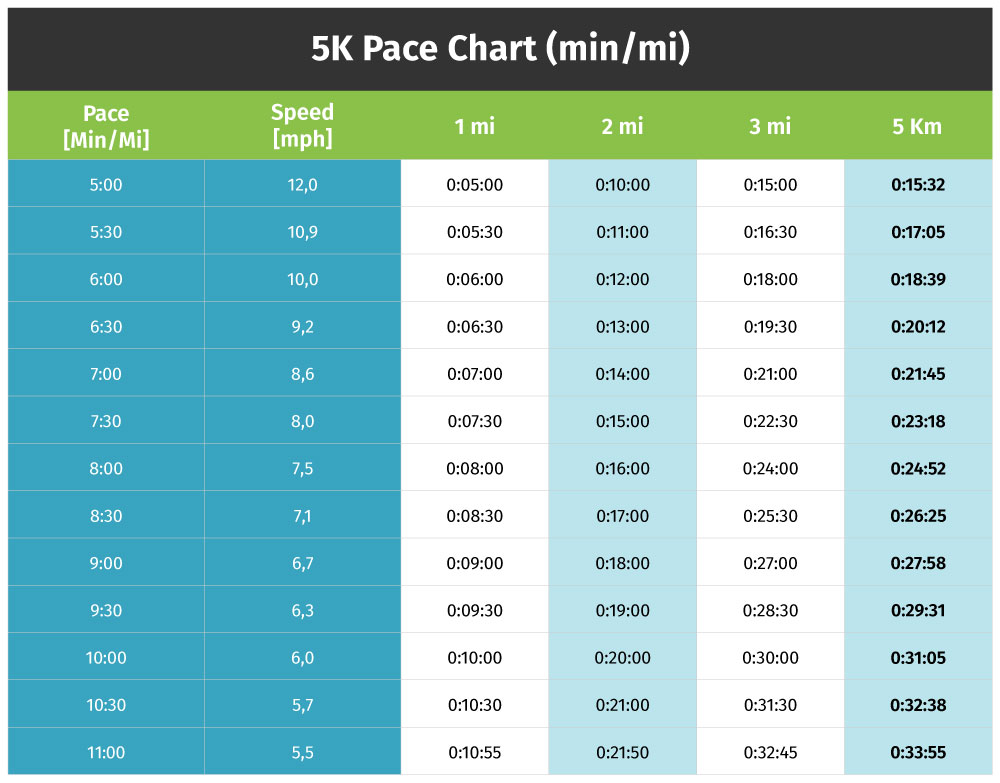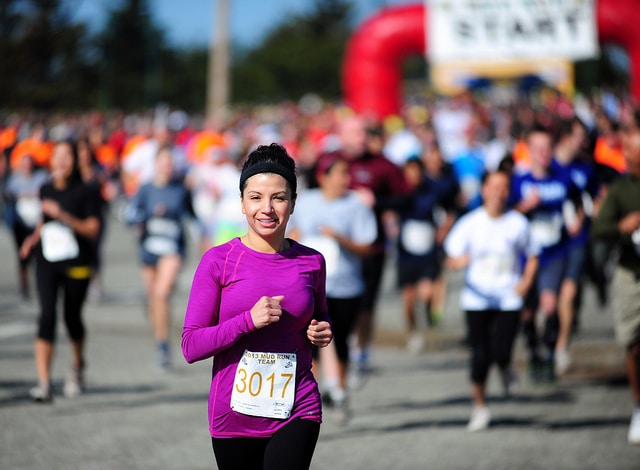Are you ready to kick your running game up a notch? Well, get excited because today’s post is all about unleashing the true power of your running potential with the magical world of tempo runs!
Picture this: you’re out on the trail, the wind gently caressing your face as you pound the pavement. Your heart’s pumping, your legs are on fire, and you feel absolutely unstoppable. That’s the feeling of tempo running – the secret sauce that can turn you into a running machine!
In this action-packed post, I’m going to uncover the mysteries of tempo runs and show you exactly how to make them an essential part of your training plan. I’ll leave no stone unturned as we dive into the core of what makes tempo runs so darn effective.
More specifically, I’ll dive into:
- What is a tempo run
- What is the purpose of a tempo run
- Why you should add tempo running to your plan
- How long should tempo runs be
- The benefits of tempo running
- What is tempo pace and how to achieve it
- How to perform tempo runs
- How often should you do tempo runs
- Can you do a tempo run on the treadmill
Sounds great?
Let’s lace up and dig in.
What is a Tempo Run
So, what exactly is a tempo run? Well, think of it as the Goldilocks of speed workouts. It’s not too slow, it’s not too fast—it’s just right. It’s like finding that perfect rhythm where your body and mind sync up in perfect harmony.
You might also hear tempo runs being referred to as lactate threshold runs. Why? Because they focus on one crucial aspect: your lactate threshold. Now, I know that sounds scientific, but bear with me. Your lactate threshold is that magical point where things start to get interesting. It’s when your muscles are working so hard that oxygen can’t keep up, and lactic acid, that notorious burn-inducing substance, starts to build up.
Yeah, we’ve all felt that burn before!
But here’s the exciting part—tempo training helps you push that lactate threshold further and further, expanding your body’s ability to handle the burn. It’s like turning up the dial on your endurance, giving you the power to crush those miles with confidence.
So, what’s the game plan? During a tempo run, you’re not going for an easy jog, and you’re definitely not sprinting like a cheetah on Red Bull. Instead, you’ll find yourself in that sweet spot, that middle ground where you’re pushing your limits but still able to maintain a strong pace. It’s the kind of effort that leaves you feeling energized, not completely wiped out.
Why should you embrace the tempo run into your training routine? Well, it’s all about taking your running to the next level. By boosting your lactate threshold, you’re teaching your body to tolerate and clear lactic acid more efficiently.
Translation: you can maintain a faster pace for longer without feeling like your legs are on fire.
What is the Ideal Tempo Running Pace?
So, what’s the game plan? Tempo sessions are all about finding that sweet spot between pushing yourself and staying in control. You’re running continuously for a solid 20 to 30 minutes, maintaining a pace that challenges you without leaving you gasping for breath.
This pace is often referred to as “comfortably hard.” It’s like striding on the edge of a thrilling adventure—challenging enough to keep you on your toes, but not so intense that you feel like you’re fighting for your life.
Now, here’s the fun part. Your tempo pace should make you both excited to reach the finish line and determined to conquer the entire session. It’s that bittersweet feeling where you’re itching to finish, but you’re also relishing the challenge of pushing yourself to your limits.
If you’re a seasoned runner, aiming for a “comfortably hard” pace means finding a speed that you can maintain for a solid 45 to 60 minutes without too much trouble. It’s slightly slower than or around the same as your 10K pace. So lace up those shoes and find your groove!
Now, let’s talk about another way to gauge your tempo pace—your heart rate. Monitoring your heart rate can give you valuable insights into your effort level. As a general rule of thumb, aim for around 80 to 90 percent of your maximum heart rate during your tempo runs.
For more on tempo training, check out the following pages:
- How to Get in That Tempo Run
- The Influence of Movement Tempo During Resistance Training on Muscular Strength and Hypertrophy Responses: A Review
- Does Tempo Training Build More Muscle?
- World-Class Long-Distance Running Performances Are Best Predicted by Volume of Easy Runs and Deliberate Practice of Short-Interval and Tempo Runs
How long Should A tempo Run be?
Tempo run distances depend mostly on your fitness level first, training goals second.
Let me explain.
Your Conditioning
As a beginner, start with no more than 10 to 15 minutes runs at your comfortably hard pace.
(I have already outlined the best tempo run for beginners below, so no worries.)
But things can be a little bit complicated when trying to match tempo run distances to training goals—that’s when you start taking your training a tad bit more serious.
The Goal Distance
The second thing that dictates your tempo run distance is the type of race you’re training for.
Here’s how to match up your tempo runs to your running goals:
- Training for a 5K race? Your tempo efforts should be around 3 to 4 kilometers.
- Training for a 10K? Keep your tempo efforts to between 4 to 7 KM.
- Training for a half marathon? Your tempo efforts should be in the range of 8 to 12 km.
- Training for a marathon? Your tempo efforts should be in the range of 16 to 24 km.
Note – Faster runners should aim to the higher end of the mileage range.
How Often To Do A Tempo Runs?
Tempo runs are like the secret ingredient in your running recipe—they add that extra dash of flavor and spice up your performance. But just like any good chef knows, too much of a good thing can be overwhelming. We don’t want to burn ourselves out or invite injury to crash the party.
So, what’s the magic number? As a general rule of thumb, I recommend incorporating one glorious tempo run into your weekly training routine. It’s the perfect frequency to challenge yourself, improve your endurance, and reap those delightful training gains. Picture it as the cornerstone of your training plan—the weekly rendezvous where you give it your all and leave everything on the road.
But hey, if you’re craving a bit more tempo goodness, I’ve got a little secret for you. Try adding a second session within a ten-day period. This way, you’ll have a chance to sprinkle in some extra flavor without overwhelming your palate.
Tempo Running VS Interval Running – What’s the difference?
Tempo running and interval running may seem similar at first glance, but their true power lies in their distinct goals. Buckle up, my running aficionados, as we embark on a journey to unravel the unique charms of these two training techniques.
Let’s start with interval training, the high-intensity sprint of the running world. Its mission? Boosting your maximum oxygen consumption, or as the cool kids call it, VO2 Max.
When you dive into the realm of intervals, get ready to enter the “no-talk” zone, where your breath becomes the conductor of your performance. You’ll find yourself uttering only a few words, as your body pushes its limits. But fear not! The recovery periods between intervals provide a much-needed respite, allowing you to stay consistent and in control throughout the session.
Now, let’s shift our focus to the captivating world of tempo training. This method has a different trick up its sleeve—it’s all about mastering the art of the lactate threshold. During a tempo run, there are no breaks.
You embrace the challenge and maintain a steady, demanding pace for a predetermined distance or time. Think of it as a continuous symphony of strength and endurance, where each step propels you closer to your goals.
By honing your lactate threshold, you unlock the ability to run faster and farther with less fatigue. It’s like fine-tuning your engine, allowing you to conquer greater distances and achieve new levels of running excellence.
Both tempo running and interval training have their rightful place in your training plan. They complement each other, like yin and yang, each contributing its unique benefits to enhance your running performance.
Tempo training elevates your endurance and ability to fight off fatigue, while interval training supercharges your aerobic capacity and unleashes your inner speed demon. Together, they create a harmonious balance, shaping you into the best runner you can be.
Can you Do a Tempo Run on Treadmill?
The beauty of the treadmill lies in its precision and control. No need to play the guessing game or rely on external factors like terrain or weather. The treadmill becomes your faithful training partner, ensuring you hit your desired tempo pace spot on.
Research and studies have shown that treadmill running can effectively replicate outdoor running in terms of exertion and physiological response. So, fear not, my tempo-loving friend, for the treadmill is a legitimate training tool for your tempo endeavors.
But wait, there’s more! The treadmill offers additional perks that can enhance your tempo running experience. You have access to valuable data at your fingertips, such as distance, time, and even heart rate monitoring. This allows you to track your progress and fine-tune your training with precision.
Oh, and let’s not forget the convenience factor.
The treadmill is available rain or shine, day or night. It’s like having your own personal running track that’s always ready for action. No need to worry about traffic, uneven surfaces, or pesky pedestrians.
How to Do a Tempo Run?
Though there are many types of tempo runs, they all have one thing in common: you can’t stop running at any point in the workout.
Sure, you still have to start with a proper warm-up and end the run with a cool-down.
But there’s no standing still throughout the run.
That’s the golden rule.
Tempo Running Workouts To Try
Here are some of the most common tempo workouts to try.
Feel free to switch between these during your training, so you get more bang for your tempo training.
The Sustained Tempo Run For Beginners
This workout is the most beginner-friendly tempo session there’s.
Sustained tempo runs come in different shapes for both beginners and advanced runners alike.
Here’s a beginner-friendly session to try:
- Start with a 10-minute warm-up. Lightly jog for 5 minutes, then perform a set of dynamic stretches while on the move for another 5 minutes.
- Run at a comfortably hard pace for 10 to 15 minutes. Remember: you can’t stop anytime during the effort so pick your pace wisely (check the previous tips on how).
- Finish with a 5-minute slow jog as a cool down. Stretch your body afterward.
The Treadmill Pace Run
The simplest tempo routines out there.
Here’s how to proceed.
- Start with a 10-minute warm-up
- Set your tempo pace, then stick with it for 20-30 minutes.
- Slow down and cool down for five minutes.
Lactate-Threshold Run
Feel confident in your running ability and want to push a little bit more? Try this more challenging variation.
Here’s how to proceed.
- Start with a 10-minute slow jog as a warm-up.
- Run for 20 to 30 minutes at your comfortably hard pace.
- Finish the run with a 10-minutes jog as a cool-down.
The Tempo Repetition
This variation looks a lot like interval-style runs, but it’s actually more challenging (since you don’t actually take any breaks throughout the workout).
This session shares a lot of similarities to classic intervals, but they’re performed at your tempo pose.
During the recovery, you never stop, but actually, keep jogging until the next rep.
Here’s how to proceed.
- Start with a 10-minute dynamic warm-up.
- Run at about pace slightly faster than your tempo pace for three minutes, then slow it down to your warm-up pace for another three
- Repeat the cycle three times, making sure not to stop during any point of the run.
- Finish with a 10-minute slow jog as a cool down.
Additional resource – How many miles is a half marathon
Hilly Tempo Runs
Another way to take your training to the next level is to do it on a hill.
This not only helps improve your endurance and speed but your strength as well.
Hill training is, after all, the best form of strength training for runners.
Locate a very long hill or mountain trail that climbs at roughly five to 10 percent grade on average and will take at least 20 to 30 minutes to run up to.
Start with an easy warm-up jog of 10 to 15 minutes, then go up the hill at tempo run effort for 20 to 30 minutes.
Aim for 85 to 90 percent of your maximum heart rate—or roughly 8.5 out of a ten on the RPE.
It’s key to properly pace yourself and keep your intensity under control early on so that you train with good technique and not build too much lactic acid in your muscles.
Marathon Pace Tempo Run – The Hanson Method
Preparing for a race?
Then this variation is for you.
Think of this as a dress rehearsal for your event.
Please keep in mind that this option is only for advanced runners.
Beginner runners don’t even dare.
- Warm-up for 15 minutes at a slow and steady pace
- Run at your goal race pace for 60 to 90 minutes.
- Cool down for 10 minutes.
The Tempo Run for Beginners – The Conclusion
There you have it!
The above tips are all you need to get started with tempo training as a runner without injuring or overwhelming yourself in the process.
All you have to do is to take action NOW.
The rest is rudimental.
Please feel free to leave your comments and questions in the section below.
In the meantime, thank you for dropping by.
Keep training strong.

















